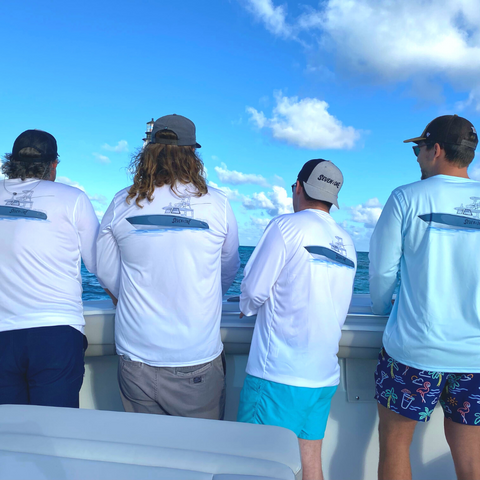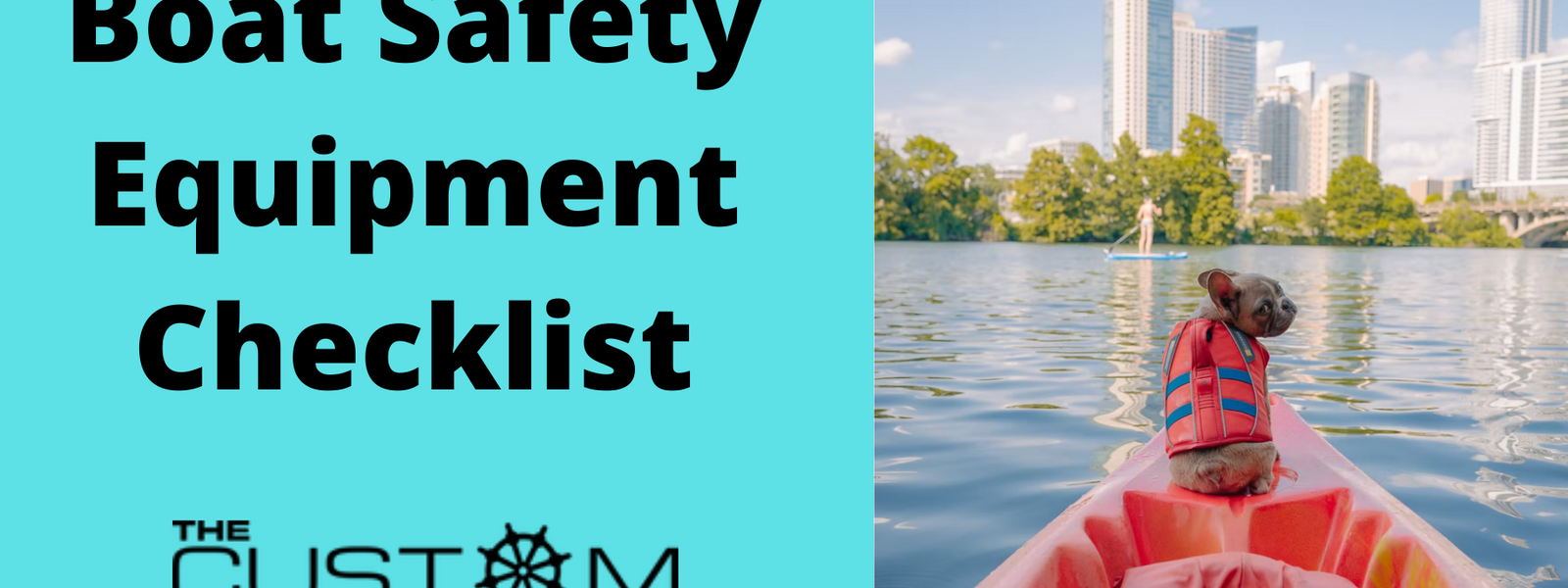As a new boater, it's tempting to make the big purchases first: fancy boating gear, custom boat merch, and high-end fishing apparel to elevate your game. But before stocking up on accessories, completing your boat safety check is essential to remain emergency-ready and legally afloat. In the spirit of “safety first,” cross these boat safety equipment items off your checklist before embarking on the next voyage.

Boat Safety Equipment Requirements
As stated in our ultimate checklist for new boat owners, new boaters must acquire the proper boating safety equipment to protect themselves and their crew. To help you swim through the murky details, we’re listing the minimum requirements for recreational boats and their safety equipment, set by the United States Coast Guard (USCG):
1. Life Jackets and Wearable Personal Flotation Devices (PFDs).
PFDs are required for everyone on board: one life jacket per person, and make sure it fits! If you or another crew member is skeptical of PFDs, remember that a life jacket can save your life - but only if you wear it. If you’re unsure of which life jacket(s) you need, here’s a cheat sheet:
- Type I, Off-Shore life jacket: This jacket provides the most buoyancy and is effective for all waters, but especially in remote areas where rescue may be delayed. It is designed to turn unconscious wearers face-up in the water.
- Type II, Near-Shore Buoyancy Vest: This is intended for calm, inland waters where rescue tends to be quicker. While it will turn some unconscious wearers face-up in the water, the turning is not as pronounced as with a Type I.
- Type III, Floatation Aid: This is intended for users in calm, inland waters or anywhere where chance of rescue is high. Wearers may have to tilt their heads back to remain face-up in the water. This is typically the most comfortable and versatile jacket for water-goers, with a variety of styles, colors, and sizes; the Type III foam design is commonly found in float coats and fishing vests.
- Any boat 16 feet or longer must also carry at least one throwable (Type IV) flotation device. As with most safety equipment, more is better: consider having a variety of Type IVs such as cushions, ring buoys, or horseshoe buoys.
2. Visual Distress Signals (VDS).
For boats on U.S. coastal waters, the Great Lakes, and territorial seas, as well as waters connected directly, USCG-approved VDS are required. Note that boats longer than 16 feet must carry VDS for both day- and nighttime use. Depending on your boat size and state, you may consider:
- Pyrotechnic devices such as red flares (for both day and night), orange smoke (for day use), and launchers for aerial red meteors or parachute flares. Note that some flares self-launch while others require a flare gun.
- Non-pyrotechnic devices such as an orange distress flag (used as a day signal only) or an electric distress light (for night use only).
3. Marine-Type Fire Extinguishers.
- Boats under 26 feet (including personal watercrafts or PWCs) need at least one B-1 type extinguisher, while boats 26 to just under 40 feet need two B-1 types or one B-2 type. Big boats (40 feet to 65 feet) require three B-I or one B-II and one B-I.
4. Proper Ventilation.
For boats that use gasoline for electrical generation, mechanical power, or propulsion, a ventilation system is legally required.
- Depending on your boat, you may use natural ventilation for marine living spaces and the tank/ bilge areas, or power blowers/ vents for non-open and gasoline-dependent boats built after July 31, 1981.
- Legal lingo aside, good ventilation is essential to prevent mildew and odors, as well as the build-up of carbon monoxide and other toxic fumes.
- For detailed, boat-by-boat ventilation requirements, Custom Captain recommends consulting the USCG boat safety guide (referenced throughout this checklist!).
- All boat owners are responsible for keeping their boat’s ventilation system in-check: make sure openings are unobstructed, ducts and ducting are intact, and blowers operate properly.
5. Backfire Flame Control.
All gasoline powered inboard/ outboard or inboard motorboats must have an approved backfire flame control device.
6. Sound Producing Devices.
- Sound devices are also useful during times of low visibility (hello, fog!) or while anchored.
7. Navigation Lights.
Boat on, lights on: vessels are required to display navigation lights between sunset and sunrise and whenever visibility is restricted (during fog, haze, etc.). There are specific light patterns required for:- Power-driven and sailing vessels less than 65.5 feet
- Power-driven vessels less than 40 feet
- Sailing vessels
- Sailing vessels less than 23 feet as well as all vessels under oars
Depending on your vessel, there are certain requirements for red navigation lights (on the portside of the bow), green lights (on the starboard side), white stern light, and white masthead light. Check out this quick and clear video for a visual refresher, and consult this detailed study guide on boat navigation lights for further details.
8. Nautical Charts.
- The National Oceanographic and Atmospheric Association (NOAA) is the U.S. nautical chart-maker.
- Note that in addition to nautical charts, boats 39.4 feet and over must also have a current copy of USCG navigation rules onboard.
Boat Safety Tips
In addition to the minimum requirements, we recommend the following boat safety precautions:
- A float plan to share with family or friends ashore. You can use this premade float plan created by the USCG, which includes key information such as:
- Description of your vessel
- Number of persons onboard and contact information
- Timeframe of boat trip
- Destination and general route
- A Personal Locator Beacon or Emergency Position-Indicating Radio Beacon (EPIRB). This battery-powered emergency transmitting device can be used as a last resort if the marine radio is inoperable or out of range. Make sure to include the Maritime Mobile Service Identities (MMSI) number for your vessel and the Unique Identification Number (UIN) on your EPIRBs and Personal Locator Beacons (PLBs) and register the UIN with NOAA.
- An EPIRB is registered to a vessel while a PLB is registered to a person. When boating by yourself, wearing a PLB with your lifejacket is especially important!
- Review types of EPIRBs here; you can peruse different models and price points here.
- A first-aid kit in a waterproof bag - because a band-aid always makes us feel better.
- A professional boat safety check!
- If you’d prefer to perform the safety check on your own, approach your vessel from the eyes of a stranger to assess its overall condition. Is your deck free of hazards? Do you have clean bilge, fully operational electrical and fuel systems, and safe galley and heating systems? Consult our checklist for a thorough boat safety check.
- If you need total peace of mind, schedule a professional boat safety review with the USCG to ensure review the requirements of this boat safety checklist, 100% free of charge. If you pass, you'll receive a USCG / Auxiliary Decal to inform relevant boating authorities (such as the Coast Guard and Harbor Patrol) that your boat was in full compliance with all federal and state boating safety laws for that year.






